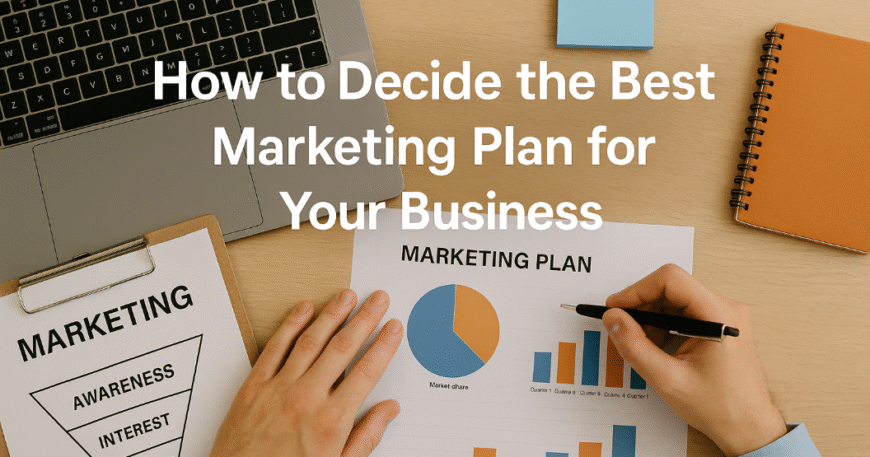
Table of Contents
- Introduction
- Understand Your Business Goals
- Identify Your Target Audience
- Analyze Competitors and Industry Trends
- Choose the Right Marketing Channels
- Set a Realistic Budget
- Map Out Your Marketing Funnel
- Test, Measure, and Optimize
- When to Pivot Your Plan
- Conclusion
Introduction
Every business—regardless of size or industry—needs a solid marketing plan to stay relevant and grow sustainably. However, deciding on the right plan can be overwhelming with so many tools, trends, and tactics available. Whether you’re launching a new product or trying to expand into a new market, the effectiveness of your marketing depends not just on execution but on strategic decision-making.
The goal of this blog is to help you evaluate your unique business situation and choose a marketing plan that is realistic, measurable, and tailored to your goals and resources.
Understand Your Business Goals
A marketing plan without clear goals is like sailing without a compass. Start by identifying what you want to accomplish in the short term and long term. Are you trying to increase brand awareness? Drive more sales? Enter a new market? Or improve customer retention?
For example, a new startup might prioritize brand visibility and website traffic, while a more established company may focus on converting leads and improving ROI. Use the SMART framework—Specific, Measurable, Achievable, Relevant, and Time-bound—to define each goal clearly. A goal like “increase website traffic by 40% in 6 months” is far more actionable than just “get more visitors.”
These goals will serve as your north star, influencing everything from budget decisions to channel selection and messaging.
Identify Your Target Audience
Knowing your audience is the bedrock of any successful marketing strategy. You need to understand not just who they are, but also how they think, what they value, and where they spend their time online.
Start by creating buyer personas, which are semi-fictional representations of your ideal customers. These personas should include demographic information (like age, gender, job title, income, and location), as well as psychographic details (such as values, motivations, pain points, and buying behavior).
For instance, if you’re selling a B2B software product, your persona might be a 35-year-old IT Director who values security, speed, and integration capabilities. If you’re in the lifestyle or fashion space, your audience might be 20-something consumers who prioritize aesthetics, brand reputation, and social proof.
By understanding your audience in depth, you can craft messages that truly resonate, select the right platforms, and avoid wasting money on channels that don’t reach them.
Analyze Competitors and Industry Trends
You don’t have to start from scratch. Looking at what your competitors are doing can offer valuable insights and inspiration. Begin by identifying your direct and indirect competitors, and study their online presence. What platforms are they active on? What kind of content are they producing? Are they running ads? How are they positioning themselves?
For example, if a competitor is seeing a lot of engagement on LinkedIn while your brand is struggling on Instagram, that could be a clue that your audience prefers professional networks over visual ones. Or if they’re ranking higher in Google search results, you may need to invest more in SEO.
You should also stay updated on broader industry trends, such as changes in consumer behavior, platform algorithms, or marketing technology. Trends like short-form video, voice search, or AI-driven personalization can affect how your audience expects to interact with your brand.
Being proactive—not reactive—when it comes to trends can help you stay ahead and avoid playing catch-up.
Choose the Right Marketing Channels
There are countless marketing channels out there, but not all of them will be right for your business. Choosing the right ones depends on your goals, your audience’s behavior, and the nature of your product or service.
Organic Channels:
Organic strategies involve no direct payment to platforms, though they require time and consistency.
- Content Marketing includes blog posts, whitepapers, and guides that educate or entertain your audience.
- SEO helps your content get discovered in search engines through keyword optimization, technical improvements, and link-building.
- Email Marketing is great for nurturing leads and retaining customers through newsletters and personalized sequences.
- Social Media platforms like LinkedIn, Twitter, or Instagram allow you to build a community and humanize your brand.
Paid Channels:
Paid strategies deliver faster results but come at a cost.
- Google Ads help you appear in search results when potential customers are actively looking for a solution.
- Social Media Ads are effective for targeting specific demographics with engaging visuals.
- Sponsored Content allows you to reach new audiences through partnerships or influencer marketing.
It’s often best to start with one or two key channels and master them before expanding. A well-balanced mix of organic and paid can deliver both short-term wins and long-term growth.
Set a Realistic Budget
Marketing can be expensive, but it doesn’t have to be wasteful. A well-planned budget ensures you allocate resources where they matter most.
Start by calculating how much you can afford to spend based on your overall revenue or growth goals. Then break that amount down by channel, campaign, or project. Consider costs like ad spend, software subscriptions, content creation, agency fees, and tools for analytics and automation.
Think about Customer Acquisition Cost (CAC)—how much you spend to acquire one new customer—and compare it with the Lifetime Value (LTV) of that customer. Ideally, your LTV should far exceed your CAC.
Also, leave room for experimentation. Allocate 10–20% of your budget to test new platforms or tactics that could uncover untapped opportunities.
Map Out Your Marketing Funnel
A successful marketing plan walks prospects through a journey, not a single transaction. This is where your marketing funnel comes into play.
- Top of Funnel (ToFu): This is the awareness stage. Your goal is to attract new people who don’t yet know about you. Use blogs, videos, podcasts, infographics, and social media content to offer value and generate interest.
- Middle of Funnel (MoFu): Here, you’re nurturing people who are aware of their problem and considering solutions. Offer case studies, comparison guides, email sequences, and webinars that help them evaluate their options.
- Bottom of Funnel (BoFu): At this stage, your audience is ready to buy. Use retargeting ads, limited-time offers, demos, and testimonials to encourage conversion.
When you structure your content around the funnel stages, you can better guide your prospects toward becoming paying customers.
Test, Measure, and Optimize
Marketing without measurement is guesswork. You need to continuously track your performance to understand what’s working—and what isn’t.
Monitor key performance indicators (KPIs) like:
- Website traffic (organic, paid, referral)
- Bounce rate and session duration
- Conversion rate (visits to leads, leads to customers)
- Cost per click (CPC) or cost per lead (CPL)
- Email open rates, click-through rates, and unsubscribes
- Social media engagement and follower growth
Use tools like Google Analytics, HubSpot, SEMrush, or Meta Ads Manager to collect and analyze data. Make regular adjustments to campaigns based on these insights. For instance, if your blog content is getting traffic but not converting, maybe the CTA needs to be more compelling. Or if an ad isn’t delivering clicks, test new creatives or messaging.
Optimization is not a one-time task—it’s a continuous process.
When to Pivot Your Plan
Click edit button to change this text. Lorem ipsum dolor sit amet, consectetur adipiscing elit. Ut elit tellus, luctus nec ullamcorper mattis, pulvinar da
Not every strategy will work perfectly, and that’s okay. The best marketers know when to pivot and try a new approach.
You may need to change direction if:
- Your campaign KPIs are consistently underperforming
- Your target audience’s behavior or preferences change
- A new competitor enters the market and disrupts your niche
- Market conditions shift due to external factors like regulations or technology
Regular reviews of your marketing performance will help you make timely decisions. Pivoting doesn’t mean starting over—it means iterating, evolving, and refining your approach based on real-world feedback.
Conclusion
Deciding on the best marketing plan for your business is not about copying what others are doing—it’s about finding the right mix of strategy, channels, content, and budget that suits your brand’s unique goals. It’s a process of understanding your audience deeply, aligning with your business objectives, and remaining agile enough to optimize and evolve as you grow.
Remember, a good marketing plan is a living document—not a one-time decision. With thoughtful planning, clear measurement, and a willingness to adapt, you can craft a strategy that delivers consistent and measurable results.




